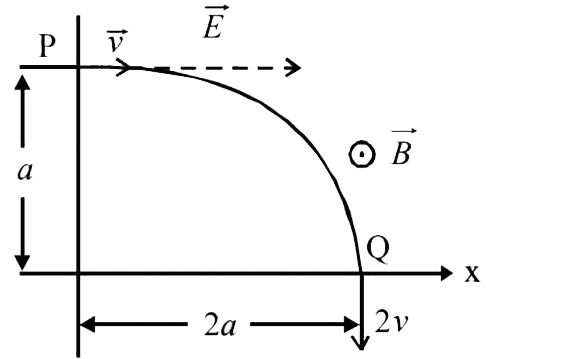A particle ( mass = m and charge = q ) is moving in a region in which there exists a uniform electric field E→i and a uniform magnetic field Bˆk. At t = 0 , the particle is at ( 0,a ) and is moving with vˆi. After some time, the particle is located at ( 2a, 0 ) and has a velocity −2vˆj , then which of the following is true ?
E=32(mv2qa)
at the initial moment, the rate of work done by electric field is 34(mv3a)
E=38(mv2qa)
at the initial moment, the rate of work done by electric field is 316(mv3a)
The correct Answer is:B
To solve the problem, we need to analyze the motion of the charged particle in the presence of both electric and magnetic fields.
1. Identify Initial and Final Conditions:
- Initial position: (0,a)
- Initial velocity: →vi=v^i
- Final position: (2a,0)
- Final velocity: →vf=−2v^j
2. Determine the Displacement:
- Displacement Δ→r=→rf−→ri=(2a,0)−(0,a)=(2a,−a).
3. Calculate the Change in Kinetic Energy:
- Initial kinetic energy KEi=12mv2.
- Final kinetic energy KEf=12m(−2v)2=12m(4v2)=2mv2.
- Change in kinetic energy ΔKE=KEf−KEi=2mv2−12mv2=4mv22−12mv2=32mv2.
4. Work Done by Electric Field:
- The work done by the electric field W=ΔKE.
- Therefore, W=32mv2.
5. Relate Work Done to Electric Field:
- The work done by the electric field can also be expressed as W=qE⋅Δ→r.
- Since Δ→r=(2a,−a) and →E=E^i, we have:
W=qE⋅(2a^i−a^j)=qE(2a).
- Therefore, equating the two expressions for work done:
qE(2a)=32mv2.
- This gives us:
E=3mv22qa.
6. Calculate Power:
- Power P is given by P=→F⋅→v.
- The force due to the electric field is →F=qE^i.
- The velocity →v=v^i.
- Therefore, the power is:
P=qE⋅v=q(3mv22qa)v=3mv32a.
Conclusion:
The correct expression for the power is P=32mv3a.
- Initial position: (0,a)
- Initial velocity: →vi=v^i
- Final position: (2a,0)
- Final velocity: →vf=−2v^j
- Displacement Δ→r=→rf−→ri=(2a,0)−(0,a)=(2a,−a).
- Initial kinetic energy KEi=12mv2.
- Final kinetic energy KEf=12m(−2v)2=12m(4v2)=2mv2.
- Change in kinetic energy ΔKE=KEf−KEi=2mv2−12mv2=4mv22−12mv2=32mv2.
- The work done by the electric field W=ΔKE.
- Therefore, W=32mv2.
- The work done by the electric field can also be expressed as W=qE⋅Δ→r.
- Since Δ→r=(2a,−a) and →E=E^i, we have:
W=qE⋅(2a^i−a^j)=qE(2a).
- Therefore, equating the two expressions for work done:
qE(2a)=32mv2.
- This gives us:
E=3mv22qa.
- Power P is given by P=→F⋅→v.
- The force due to the electric field is →F=qE^i.
- The velocity →v=v^i.
- Therefore, the power is:
P=qE⋅v=q(3mv22qa)v=3mv32a.
The correct expression for the power is P=32mv3a.
Similar Questions
A particle of mass m and charge q is thrown in a region where uniform gravitational field and electric field are present. The path of particle:
View SolutionA particle having charge q moves with a velocity v through a region in which both an electric field →E and a magnetic field B are present. The force on the particle is
View SolutionA particle of mass m and charge Q moving with a velocity v enters a region on uniform field of induction B Then its path in the region is s
View SolutionAn alpha particle moving with the velocity →v=uˆi+ˆj ,in a uniform magnetic field →B=Bˆk . Magnetic force on alpha particle is
View SolutionA particle of mass .m. and charge q is placed at rest in a uniform electric field E and then released. The K.E. attained by the particle after moving a distance y is
View SolutionA particle of charge +q and mass m moving under the influence of a uniform electric field Eˆi and uniform magnetic field Bˆk follows a trajectory from P→Q as shown in fig. The velocities at PandQ are vˆi and −2vˆj . which of the following statement(s) is/are correct ?

View SolutionA positively charged particle is moving along the positive x-axis in a unifom electric field→E=E0ˆj and magnetic field →B=B0ˆk (where E0 and B0 are positive constants), then
View SolutionA charged particle moves in a uniform magnetic field. The velocity of the particle at some instant makes an acute angle with the magnetic field. The path of the particle will be
View SolutionA charged particle moving along +ve x-direction with a velocity v enters a region where there is a uniform magnetic field B0(−ˆk),omx=0→x=d. The particle gets deflected at an angle θ from its initial path. The specific charge of the particle is

View SolutionA particle of mass m and charge q is placed at rest in a uniform electric field E and then released, the kinetic energy attained by the particle after moving a distance y will be
View Solution
